Compressed air filters
1. What is a compressed air filter?
A compressed air filter is a crucial component in many industrial settings, designed to clean and purify compressed air from the compressor by removing contaminants such as dust, dirt, oil aerosols, and moisture that can compromise the performance and lifespan of equipment reliant on air power.
These filters help maintain the efficiency of machines and prevent costly downtime and repairs. The incorporation of these filters can also significantly reduce product defects in manufacturing environments, where even minor contamination can lead to substantial quality issues.
Ultimately, the investment in quality compressed air filtering solutions not only enhances operational reliability but also promotes a safer and more efficient work environment.
2. The importance of compressed air filters in industrial applications
Compressed air filters play a pivotal role in industrial applications by ensuring that the air system functions optimally and safely. In many industries, the quality of compressed air is directly linked to the quality of end products, making filtration an indispensable part of the production process.
- In food production, even trace amounts of contaminants can lead to severe hygiene issues and compromise food safety, thereby necessitating rigorous air filtration standards.
- In car manufacturing, unfiltered air can introduce particulate matter that may impair the precision manufacturing of components, potentially leading to increased defects and recalls.
Choosing the right compressed air filter
Key factors
When selecting a compressed air filter, several key factors must be considered to ensure optimal performance and compatibility with your specific requirements:
- Level of Purity Needed: Assess the required air cleanliness based on industry standards (e.g., higher purity for pharmaceutical manufacturing).
- Operating Conditions: Evaluate pressure, temperature, and flow rate to ensure the filter can withstand these conditions.
- Types of Contaminants: Identify common contaminants (e.g., oil aerosols, moisture, particulate matter) to select a filter designed for specific impurities.
- Total Cost of Ownership: Consider the initial purchase price, maintenance, and filter replacement costs over time.
Filter efficiency
Further specifications are important when evaluating filters. In addition to technical data such as connection size, flow rate and grade of filtration, two other specifications are important when evaluating filters.
This efficiency value specifies to what extent the concentration of particles is reduced by the filter, expressed as a percentage. Efficiency is designated with the µ symbol or the letter E, and is specified as a percentage.
As a rule, concentrations are specified in grams per cubic metre. However, in the case of weak concentrations the number of particles per cubic centimetre is specified [Z/cm³]. This applies above all in the case of high performance filters.
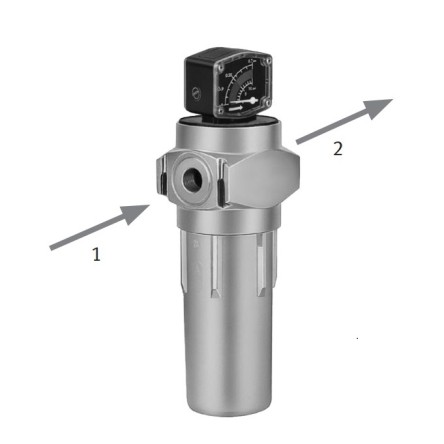
- Altered concentration of particles
- 1 Input concentration
- 2 Output concentration
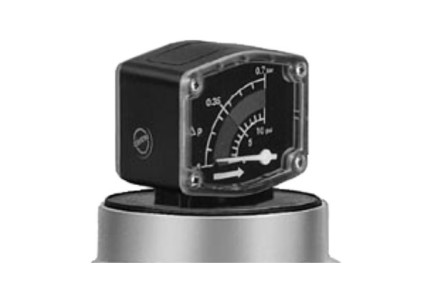
Pressure drop
With regard to flow, filters can be seen as resistors. For this reason, pressure difference Δp occurs between the inlet and the outlet. For a new filter, pressure drop lies within a range of 0.02 to 0.2 bar.
Pressure drop increases over the entire service life of the filter due to the accumulation of particles. However, it should not be allowed to exceed a value of 0.6 bar, because the resulting consequences become plainly apparent and the system no longer functions economically.
For this reason, most devices are equipped with differential pressure gauges, which usually identify critical and non-critical ranges in addition to displaying the pressure drop value.
Compressed Air Filters from Festo
Festo compressed air filters can be found in two products lines, MS Basic and MS Series lines, two complementary solutions for effective compressed air preparation:
- MS basic series: Designed for those seeking powerful, lightweight, and cost-effective options, delivering all the essential functions at an attractive price.
- MS Series: Provides advanced features that enhance system performance, allowing for a sophisticated air preparation solution.
Together, these product lines allow you to mix and match according to your needs, ensuring you have both the affordability of MS Basic and the sophisticated capabilities of the MS Series.
To help you select the right products for your project requirements, we provide our Air preparation service unit sizing tool. This tool allows you to quickly and easily determine the necessary air quality for your application and identify suitable devices that comply with the specified compressed air standards. With this resource, you can explore your options and find the ideal solutions to meet your needs.
Types of Compressed air filters
Centrifugal separators
The centrifugal separator is a sort of coarse pre-filter for water droplets and larger particles of dust and contamination (larger than 50 µm). Expressed in simple terms, the centrifugal separator functions like a air centrifuge.
A vortex insert is situated within the flow of air (from bottom to top) which imparts rapid rotary motion to the air. The resulting centrifugal forces sling the heavier particles – namely water and coarse contamination – radially onto the outside wall from which they run down into a collecting tank. The particles crash against the wall and flow into a collecting bowl.
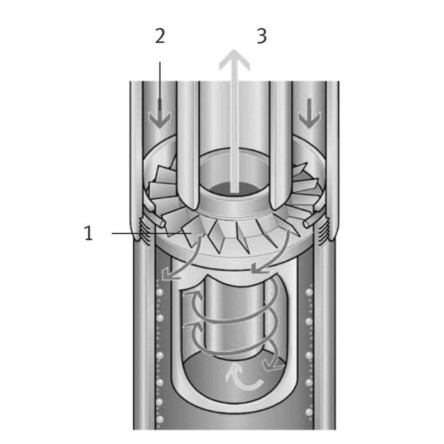
- Detail of a centrifugal separator
- 1 Vortex insert
- 2 Inflowing air
- 3 Outflowing air
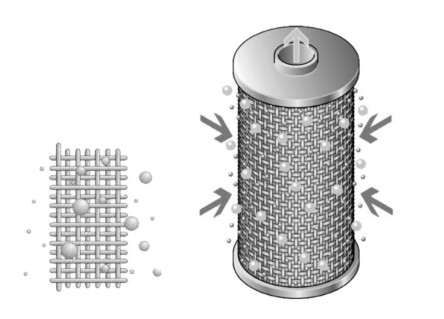
Pre-filters
Pre-filters are basically fine sieves. They're almost always round, and air flows through them from the outside to the inside. Particulates – and to a minimal extent oil and water – are collected on the surface. The size of the pores determines the size of the particles which can be filtered out. These filters can be regenerated by simply washing them.
With a filtered particle size within a range of 5 to 40 µm, these filters are usually adequate for "normal" requirements, making any additional filters unnecessary.
Pressure drop must be taken into consideration during use, which can be determined relative to flow rate in the diagrams provided in the manufacturer's catalogue.
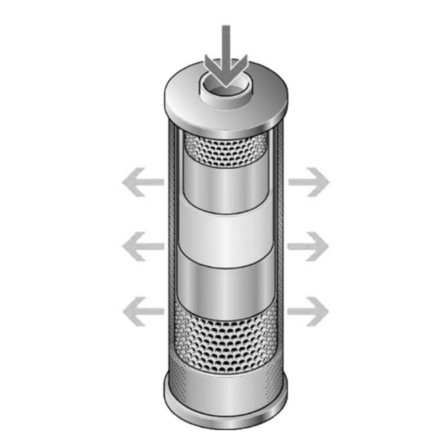
Micro-filters (coalescence or high performance filters)
Micro-filters are filters for demanding requirements. Residual oil content is reduced to a value of 0.01 mg/m³ – which corresponds to class 1 compressed air quality – and the filtered air is thus virtually oil-free. Contamination particles with sizes of down to 0.01 µm are filtered out, which also corresponds to class 1. The filters consist of a fibrous web laid in pleats which is made up of a jumble of many individual fibres.
Air flows through micro-filters from the inside to the outside. Oil and water are gradually forced to the outside, and thus a portion of the condensate escapes from the filter. The service life of the filter is increased as a result.
In this case as well, pressure drop relative to flow rate must be taken into consideration during operation.
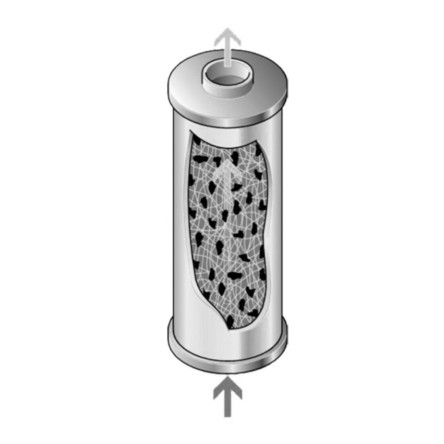
Active carbon filters/active carbon adsorbers
In the case of active carbon filters, hydrocarbons are bound to the active carbon by means of adhesion. However, active carbon cannot be regenerated. Residual hydrocarbons, as well as odours and gustatory substances are filtered out, which are not removed by the micro-filter. Quality standards required for breathing air are fulfilled in this way.
An active carbon filter must always be equipped with an upstream dryer and micro-filter. In the case of adsorbers, a micro-filter must even be installed downstream, because the compressed air may carry very fine carbon particles smaller than 1 µm.
The range of applications for both of these filter types includes:
- Food and luxury food industry
- Pharmaceuticals
- Chemicals industry
- Surface finishing
- Medical engineering.
However, their service lives differ:
- Active carbon filters Approx. 300 to 400 hours
- Active carbon adsorbers Approx. 8000 to 10,000 hours